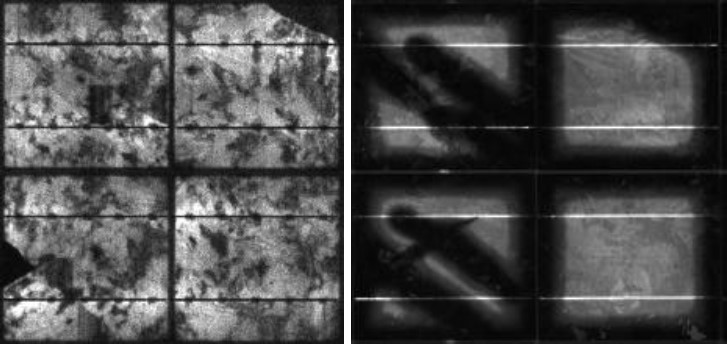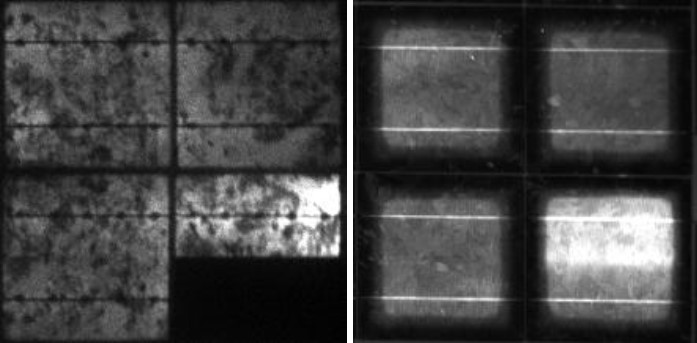UV fluorescence as a characterization tool for PV modules in the field
We use the fluorescence effect of the lamination material of the PV modules to detect cell cracks, cracked connectors and hot spots in wafer-based solar cells. For this purpose, the PV modules are individually irradiated with black light and the fluorescence light is measured by a camera for a total of 10 seconds per module. The measurement is carried out in the dark. This new mobile application of the fluorescence method enables non-contact and fast analysis of module defects during operation.
The UV fluorescence of ethylene vinyl acetate (EVA) was first used by Pern et al. in 1996 to analyze the yellowing of PV modules. Due to the sunlight exposure of EVA, the UV component of the spectrum breaks up molecules in the lamination film so that chromophores are formed in the EVA. A correlation between structures in UV fluorescence images and cell cracks was first published by Schlothauer et al. in 2010.
Pern has shown that the fluorescent degradation products in the EVA film are polyenes resulting from UV-induced structural changes in the polymer chains of the EVA. Other EVA additives may also contribute to UV fluorescence, but this process is not yet understood in detail. Where oxygen is present, the fluorescent degradation products are transformed into non-fluorescent products by a photooxidation process. Along the edges and fractures in solar cells, oxygen can diffuse into the module and the photooxidation process competes with photodegradation. This process marks the cell edge and cell cracks with a non-fluorescent trace.
Fig. 1 shows the change in the fluorescence of EVA compared to an electroluminescence image in which cell cracks are visible. The cell cracks are much more clearly visible in the fluorescence image than in the electroluminescence image. We use this effect to determine the number, position and orientation of cell cracks in PV modules. In addition, fluorescence increases over time, when parts of the PV module are hotter than under normal conditions. This also enables the detection of faults such as hot spots or interrupted cell connector ribbons. Fig. 2 shows a part of a PV module with broken cell connector imaged once with the electroluminescence method and once with the fluorescence method. To determine UV fluorescence outdoors reliably and with little effort, the PV modules should have been weathered outdoors for at least three summer months.
As already mentioned, photooxidation takes time to build up a non-fluorescent trace along cell cracks. This effect can be used to distinguish between fresh and old cell cracks. This is useful, for example, to clarify whether a cell crack was recently caused by a hailstorm or by prolonged mechanical stress.
Fluorescence measurement is a simple, reliable and powerful tool for quality control of PV modules.


